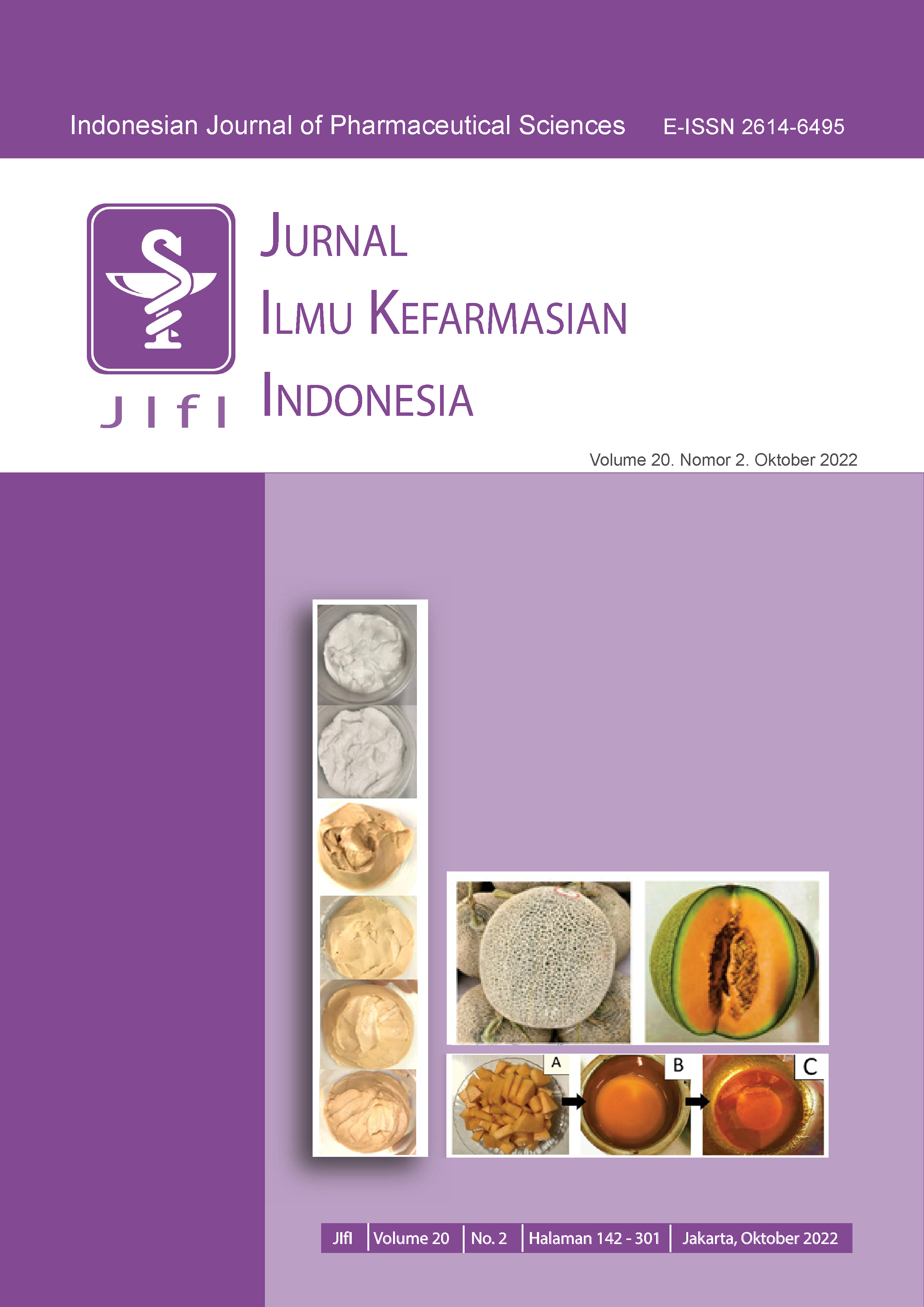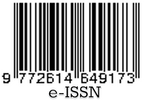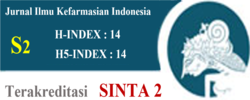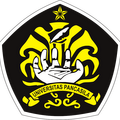Formulation of Moisturizer Cream Containing Orange Melon (Cucumis melo L. var. reticulatus) Fruit Extract
Abstract
Environmental factors such as extreme sunlight may disrupt skin’s moisture balance and cause the skin to dry out. Therefore, skincare products such as moisturisers are highly needed. In this study, orange melon (Cucumis melo L. var. reticulatus) was added to increase the value of the moisturiser product. Orange melon contains sucrose as the moisturising substance and antioxidant substance which helps to normalize the skin. The extraction process was carried out using juicer. The fruit extract was used at 10% (FI), 20% (FII), and 30% (FIII). This study aims to know the impact of increasing orange melon extract concentration on the physical characteristics of cream and its moisturising effect and antioxidant activity as well as the best formula. The evaluations consisted of physical characteristics, moisturising effect, and antioxidant test with DPPH method. The statistical results showed that the increase in extract concentration significantly affect the physical characteristics (pH, viscosity, spreadibility, ease of removal, adhesivity) and moisturising effect of the creams. Increasing extract concentration would cause a significant increase in the moisturising effect of creams containing synthetic humectants. The best formula which fulfilled the requirements of physical characteristics and effectiveness test, while possessing antioxidant effect was F2 (20% orange melon extract).
References
2. Mathlouthia M, Genotelleb J. Role of water in sucrose crystallization. Carbohydrate Polymers. 1998. 37: 335-342.
3. Burger Y, Saar U, Nurit K. A single recessive gene for sucrose accumulation in Cucumis melo fruit. Journal of American Society for Horticultural Science. 2002. 127(6): 938-943.
4. US Department of Agriculture (USDA), Classification for Kingdom Plantae Down to Genus Cucumis L. USDA Natural Resources Conservation Service. Washington D.C. diambil dari http://www.ars.usda.gov/ba/bhnrc/ndl. Diakses pada 25 September 2021.
5. Devi V, Sharmila S, Divyapriya S. Invitro cytotoxicity and free radical scavenging activity of aqueous extract of Cucumis melo. International Journal of Pharmaceutical and Biological Research (IJPBR). 2011. 2(6): 150-156
6. Hidayatullah S. Statistika Farmasi. Edisi Pertama.Yogyakarta. Innosain. 2018.
7. Weihong GM. Comparison of Stacking and Nonstacking on Melon and Musk melon (Cucumis melo) Production. ARC Training, New York. 1996.
8. Direktorat Jenderal Pengawasan Obat dan Makanan Republik Indonesia (DitJen POM RI). Parameter Standar Umum Ekstrak Tumbuhan Obat. Cetakan Pertama. Jakarta: Departemen Kesehatan Republik Indonesia. 2000.
9. Ittiyavirah S, George A, Santhosh A, Kurian S, Pappachan P, Jacob G. Studies of cytotoxic potential of Cucumis melo Linn. fruit aqueous extract. Iranian Journal of Pharmacology and Therapeutics. 2012. 12: 24-29.
10. Rawlins EA. Bentleys of Pharmaceutics. 8th ed. London Baillierre Tindal. 2010.
11. Singh M, Sharma S, Khokra SL, Sahu RK, Jangde R. Preparation and evaluation of herbal cosmetic cream. Pharmacology Online. 2011. 2: 1258-1264
12. Aswal A, Kalra M, Rout A. Preparation and evaluation of polyherbal cosmetic cream, Der Pharmacia Lettre. 2013. 5(1): 83-88.
13. Departemen Kesehatan Republik Indonesia (DepKes RI). Formularium Kosmetika Indonesia. Cetakan I. Jakarta. Departemen Kesehatan Republik Indonesia. 1985.
14. Akash S, Karekar P, Yadav A. Formulation and evaluation of multipurpose herbal cream. International Journal of Science and Research (IJSR). 2015. 4(11):12.
15. Hajare M, Nitalikar M, Mohite M, Shid SJ, Dange VN. Formulation and optimization of dermatological dosage form for comparative in-vitro evaluation of semisolid bases. Research Journal of Topical and Cosmetic Sciences. 2016. 4(1): 1-4.
16. Kulkarni RV, Sreedhar V, Mutalik S, Setty M, Interpenetrating network hydrogel membranes of sodium alginate and poly(vinyl alcohol) for controlled release of Prazosin Hydrochloride through skin. International Journal of Biological Macromolecules. 2010. 47:520–527.
17. Lachman L, Lieberman AH, Kanig JL. The Theory and Practice of Industrial Pharmacy. Diambil dari : https://www.hktechnical.com/2021/03/free-pdf-lachmans-theory-and-practice.html. Diakses pada 25 Maret 2022.
18. Martin AN, Swarbick J, Camarata A. Physical Pharmacy. Diterjemahkan dari Bahasa Inggris oleh Yoshita. Edisi 3. Penerbit Universitas Indonesia (UI Press). Jakarta. 2011.
19. Rowe RC, Sheskey PJ, Quinn ME. Handbook of Pharmaceutical Excipient. 9th ed. Pharmaceutical Press and American Pharmacist Association. London. 2020.
20. Battistel MD, Pendrill R, Widmalm G, Freedberg DI. Direct evidence for hydrogen bonding in Glycans: A combined NMR and Molecular Dynamics Study. Journal of Physical Chemistry B. 2013. 117(17): 4860-4869.
21. White JS. ‘Sucrose, HFCS, and Fructose: History, Manufacture, Composition, Applications, and Production’ dalam White JS, Rippe J. (eds.). Fructose, High Fructose Corn Syrup, Sucrose and Health. Humana Press. New York. 2014.
22. Widowati W, Widyanto RM, Laksmitawati DR, Erawijantari PP, Wijaya L, Sandra F. Phytochemical, free radical scavenging, and cytotoxic assay of Cucumis melo L. extract and β-carotene. Journal of Advanced Agricultural Technologies. 2015. 2(2):16.
23. Beaulieu JC, Grimm CC. Identification of volatile compounds in Cantaloupe at various developmental stages using solid phase microextraction. Journal of Agricultural and Food Chemistry. 2001. 49:1345-1352.
24. Lamikanra O,Watson MA. Cantaloupe melon peroxidase: characterization and effects of additives on activity. 2000. Nahrung, 44(3): 168-172.
25. Young A. Practical Cosmetic Science. 2nd ed. Mills and Boon Limited Publisher. London. 2002.
26. Aulton M, Taylor K. Aulton’s Pharmaceutics: The Design and Manufacture of Medicine. 6th ed. Churchill Livingstone. Leicester. 2021.

This work is licensed under a Creative Commons Attribution-NonCommercial-ShareAlike 4.0 International License.
Licencing
All articles in Jurnal Ilmu Kefarmasian Indonesia are an open-access article, distributed under the terms of the Creative Commons Attribution-NonCommercial-ShareAlike 4.0 International License which permits unrestricted non-commercial used, distribution and reproduction in any medium.
This licence applies to Author(s) and Public Reader means that the users mays :
- SHARE:
copy and redistribute the article in any medium or format - ADAPT:
remix, transform, and build upon the article (eg.: to produce a new research work and, possibly, a new publication) - ALIKE:
If you remix, transform, or build upon the article, you must distribute your contributions under the same license as the original. - NO ADDITIONAL RESTRICTIONS:
You may not apply legal terms or technological measures that legally restrict others from doing anything the license permits.
It does however mean that when you use it you must:
- ATTRIBUTION: You must give appropriate credit to both the Author(s) and the journal, provide a link to the license, and indicate if changes were made. You may do so in any reasonable manner, but not in any way that suggests the licensor endorses you or your use.
You may not:
- NONCOMMERCIAL: You may not use the article for commercial purposes.
This work is licensed under a Creative Commons Attribution-NonCommercial-ShareAlike 4.0 International License.





 Tools
Tools





















